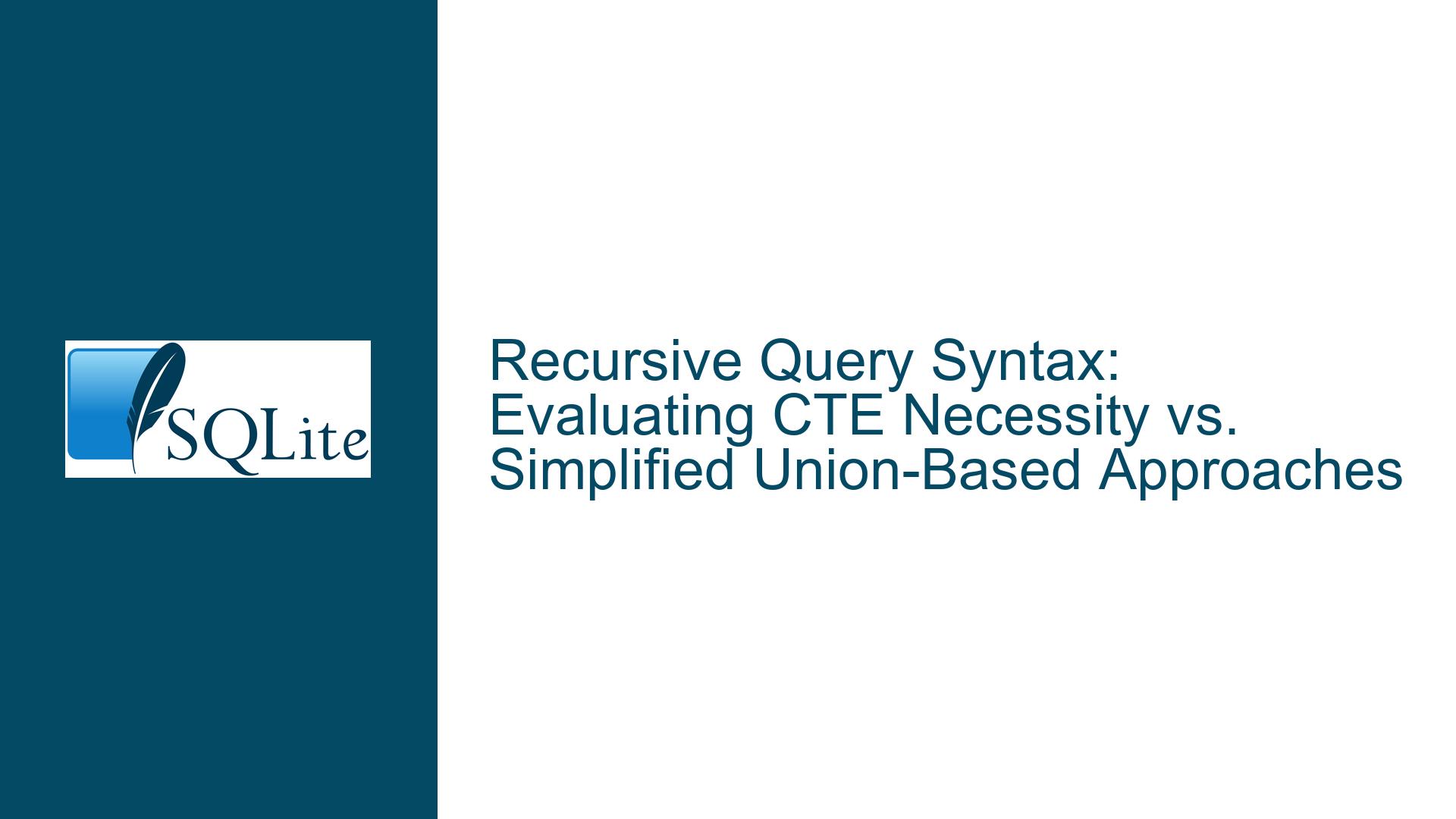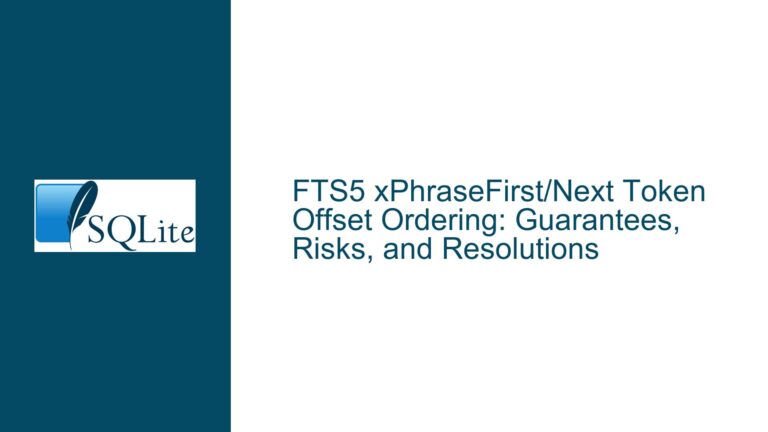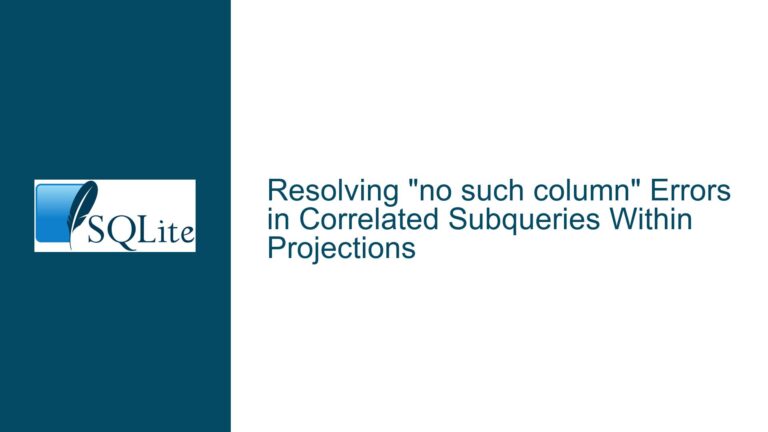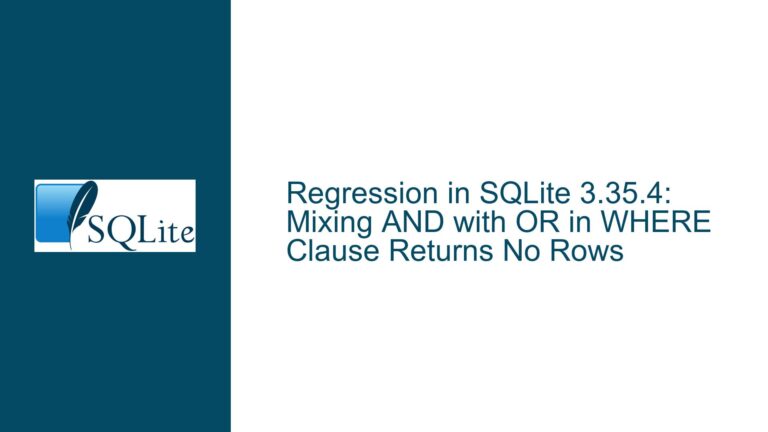Recursive Query Syntax: Evaluating CTE Necessity vs. Simplified Union-Based Approaches
Understanding Recursive Query Mechanics in Hierarchical Data Structures
The core challenge revolves around expressing recursive relational queries in SQLite without relying on Common Table Expressions (CTEs). A hierarchical dataset, such as a tree structure stored in a table with parent-child relationships, requires traversing multiple levels to compute properties like transitive closure (e.g., finding all ancestors or descendants of a node). The standard approach uses a recursive CTE, but an alternative proposal suggests replacing the CTE with a direct reference to the UNION operation’s intermediate results.
In the example provided, a table items defines a tree with nodes and their parents. The goal is to generate a transitive closure table containing each node’s ID, root ID, and depth level. The recursive CTE approach achieves this by:
- Base Case: Selecting initial nodes as their own roots with level 0.
- Recursive Step: Joining child nodes to parent nodes iteratively, incrementing the level.
The proposed alternative replaces the CTE’s name (transitive_closure) with a direct reference to the UNION result (e.g., FROM UNION tcitems). This eliminates the need to name the CTE, declare it in a WITH clause, or write a final SELECT outside the CTE. While this simplifies syntax superficially, it introduces ambiguities about scoping, execution order, and compatibility with SQL standards.
Key questions arise:
- Can SQL engines resolve recursive dependencies without explicitly named CTEs?
- Does the
UNIONoperation inherently support self-referential recursion? - What are the trade-offs between syntactic brevity and functional robustness?
Ambiguities in Syntax, Execution Order, and SQL Standard Compliance
1. Implicit Referencing of Intermediate Results
SQL engines execute queries in stages, materializing intermediate results temporarily. In the standard CTE approach, the recursive CTE’s name (transitive_closure) acts as an anchor for the engine to iteratively build the result set. The proposal to reference UNION directly assumes that the intermediate result of the union is addressable as a table-like entity. However, SQLite (and most SQL dialects) do not expose the UNION result as a named or implicit temporary table during query execution. This violates the scoping rules of SQL, where subqueries and set operations like UNION cannot self-reference their own outputs unless explicitly materialized (e.g., via CTEs or temporary tables).
2. Recursion Semantics Without Named Anchors
Recursive CTEs rely on a fixed-point iteration process:
- The base case is evaluated first.
- The recursive term repeatedly joins the CTE’s previous iteration until no new rows are added.
By naming the CTE (transitive_closure), the engine knows which entity to iteratively expand. Removing the name breaks this contract, as there is no anchor for the recursion. The FROM UNION syntax does not specify how the engine should track iterations or terminate the recursion. Without a named anchor, the engine cannot distinguish between the base case and recursive step, leading to undefined behavior or infinite loops.
3. Compatibility with SQL Standards and Portability
The SQL standard mandates explicit naming for recursive CTEs. SQLite adheres to this standard, requiring a WITH clause for recursive queries. Deviating from this syntax risks incompatibility with other databases and tools that expect CTE-based recursion. Portability concerns arise when applications depend on non-standard syntax, limiting their ability to migrate across database systems.
4. Optimization and Performance Implications
CTEs in SQLite are optimized as materialized or inlined subqueries depending on context. Named CTEs allow the engine to apply optimizations like memoization or early termination. A UNION-based approach obscures the recursive intent, potentially disabling these optimizations and leading to inefficient execution plans. For large hierarchies, this could result in excessive memory usage or slower convergence.
Validating Syntax, Resolving Ambiguities, and Implementing Alternatives
Step 1: Diagnosing Syntax Errors and Scope Limitations
Attempting to execute the proposed UNION-based query in SQLite results in an immediate syntax error:
Error: near "UNION": syntax error
The FROM UNION clause is unrecognized because UNION is an operator, not a table source. To resolve this, revert to the standard CTE syntax and validate its correctness:
WITH RECURSIVE transitive_closure(id, root_id, level) AS (
SELECT id, id, 0 FROM items
UNION ALL
SELECT items.id, tc.root_id, tc.level + 1
FROM items
JOIN transitive_closure tc ON items.parent_id = tc.id
WHERE items.id != items.parent_id
)
SELECT * FROM transitive_closure;
This query succeeds because it explicitly names the CTE (transitive_closure), allowing the engine to reference it recursively.
Step 2: Simulating Implicit Recursion via Temporary Tables
If avoiding CTEs is a strict requirement, emulate recursion using temporary tables:
-- Initialize with base case
CREATE TEMP TABLE temp_tc AS
SELECT id, id AS root_id, 0 AS level FROM items;
-- Iterate until no new rows are added
WHILE (1) BEGIN
INSERT INTO temp_tc
SELECT items.id, tc.root_id, tc.level + 1
FROM items
JOIN temp_tc tc ON items.parent_id = tc.id
WHERE items.id != items.parent_id
AND NOT EXISTS (
SELECT 1 FROM temp_tc
WHERE id = items.id AND root_id = tc.root_id
);
-- Terminate if no rows inserted
IF changes() = 0 BREAK;
END;
SELECT * FROM temp_tc;
This approach manually implements fixed-point iteration but introduces complexity:
- Requires temporary tables and loop control.
- Risks infinite loops if termination conditions are misconfigured.
- Lacks the elegance and portability of CTEs.
Step 3: Leveraging Views for Code Reuse
If the goal is to avoid repeating the CTE name, encapsulate the logic in a view:
CREATE VIEW transitive_closure_view AS
WITH RECURSIVE tc(id, root_id, level) AS (
SELECT id, id, 0 FROM items
UNION ALL
SELECT items.id, tc.root_id, tc.level + 1
FROM items
JOIN tc ON items.parent_id = tc.id
WHERE items.id != items.parent_id
)
SELECT * FROM tc;
-- Usage
SELECT * FROM transitive_closure_view;
Views provide abstraction without sacrificing standard syntax.
Step 4: Analyzing Performance and Readability Trade-Offs
Compare execution plans for CTE vs. temporary table approaches using SQLite’s EXPLAIN command. CTEs often outperform manual iterations due to engine-level optimizations. For example:
EXPLAIN QUERY PLAN
WITH RECURSIVE transitive_closure(...) ...;
Versus:
EXPLAIN QUERY PLAN
SELECT ... FROM temp_tc ...;
The CTE’s plan will show efficient joins and early termination checks, whereas the temporary table approach may reveal full table scans.
Step 5: Advocating for CTE Best Practices
CTEs are not “harmful” but are a tool for clarity and maintainability:
- Self-Documenting: Named CTEs make queries easier to understand.
- Portable: Compatible with PostgreSQL, MySQL, and other databases.
- Optimizable: SQLite can apply recursion-specific optimizations.
If syntactic brevity is critical, use concise CTE names and avoid unnecessary columns:
WITH RECURSIVE tc AS (
SELECT id, id AS root, 0 AS lvl FROM items
UNION ALL
SELECT i.id, tc.root, tc.lvl + 1
FROM items i JOIN tc ON i.parent_id = tc.id
WHERE i.id != i.parent_id
)
SELECT * FROM tc;
Step 6: Proposing Language Enhancements
While SQLite does not support FROM UNION, future extensions could introduce syntax for anonymous recursion. For instance, a hypothetical RECURSIVE UNION keyword might allow:
SELECT ...
UNION RECURSIVE
SELECT ... FROM UNION ...
This would require parser changes and consensus from the SQLite community. Until then, CTEs remain the only viable method.
By systematically addressing syntax errors, emulating recursion manually, and advocating for CTE best practices, developers can balance brevity and robustness in hierarchical queries. The proposed UNION-based approach, while innovative, conflicts with SQL’s scoping rules and optimization frameworks, making CTEs the superior choice for recursive queries in SQLite.






